Taming the Clothes
I have been asked by a number of readers and students if I’ve read Marie Kondo’s hugely popular book called The Life-Changing Magic of Tidying Up. The answer is, yes.
I’ve not just read it, I’ve put some of her tidying suggestions to the test in my own home.
Her book, and my experience of it, has been so provocative, that I’ve written articles on four topics already – which I’ll share over the next four weeks in this order:
- Taming the Clothes
- Taming Paper Clutter
- Does it Spark Joy?
- Tidy All At Once or Bit by Bit?
As you can tell, I have quite a bit to say about this little book that has captured the world by storm. Even if you haven’t read Kondo’s book, you may find my remarks helpful in your journey. If you have read it, I’d love to hear how her methods are working for you. Use the comment thread below to share your experiences and help us all come out of our respective (cluttered) closets.
Part 1
Taming the Clothes: Folding
For such a simple task, folding laundry (mindfully) and putting it away is one of the best practices I know to cultivate ease. I love it for what it does to calm the nervous system and quiet the mind.
Until I read Kondo’s book I never thought that there was an art to it as well.
Her method sounded beautifully zen, so I wanted to try it. (I’ll try anything if it will love-up our home spaces and simplify our lives.) Kondo suggests a technique that allows for the garment to be stored upright in a drawer to create more space, make it easier to see and find later, and free clothing from getting piled upon, which, she says, creates more wear and tear and wrinkles. (Who knew?)
I tried it one muggy afternoon with my folded piles – one drawer at a time. All my underwear, socks, tops, T-shirts, scarves, nightgowns, swimwear, sweaters, sweatshirts, and sweatpants underwent a major makeover.
After about two hours of folding the KonMari way, I was amazed – giddy, in fact – at the possibility that this much empty space could be created! These photos will give you an idea of the effect it had on my scarves.
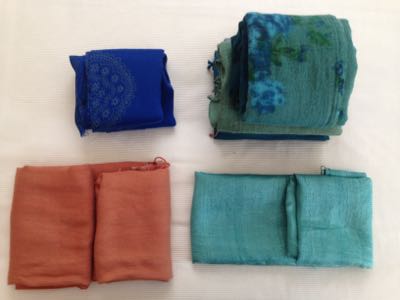
Step 2: Folded lengthwise into long strips, then again in halves or thirds. Made adjustments as needed so that they fit vertically in my drawer. They ended looking more square than rectangular.
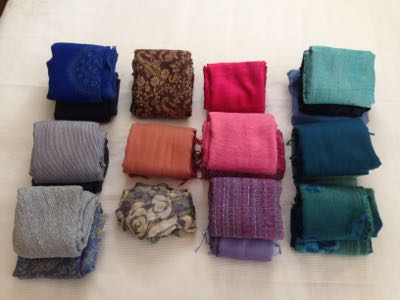
Step 3: Admired my little bundles on the bed before transferring them to the drawer. Don’t they look sweet?
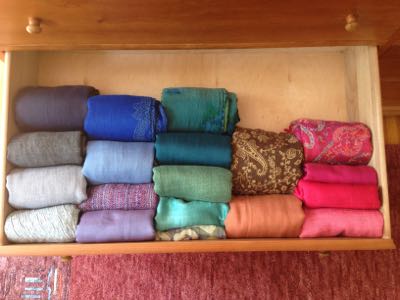
Step 4: Oriented the thicker, fall-winter ones towards the left and the thinner, spring-summer ones towards the right.
From bureau drawers I eagerly moved to the shelves in the closet, pulling out the bulkier things and throwing them into piles on the bed: sweaters, sweatshirts, sweatpants, cargo pants. Folding these took longer for some reason and putting them away did not feel as satisfying because they disappeared into the back of the shelf.
Folding fatigue began to set in.
After I finished putting away the last item, my giddiness had faded into a blur of exhaustion. I was cooked.
As I took inventory of my progress, I was surprised (more like shocked) to discover that I was not in love with my efforts.
The smaller things like scarves, underwear, and socks were not the problem. It was the larger tops and T-shirts that felt a bit rigid in their new upright envelop bundles. Though the space-making effect was dramatic, some of my clothes in the emptier drawers felt oddly more tight – like there was less breathing room – if that makes any sense. And due to their more compact size, my sweaters and sweatshirts were harder to see.
It was time to stop.
Intuitive Adjustments
All that changed the next day. I needed time to get used to, and integrate, the transformation. I also needed to make some intuitive adjustments.
Applying Kondo’s suggestion for hanging clothes [that orient thicker, larger, and darker garments on the left, and the thinner, smaller, lighter fabric garments on the right], I moved the contents of some of my drawers around too: thicker, fall-winter, long-sleeved tops and T-shirts to the left; thinner, spring-summer, short-sleeve ones to the right.
There was something about having gym T-shirts mixed in with my nice ones that didn’t feel right either, so I moved them into their own drawer – a new space that had been freed up by all my micro adjustments.
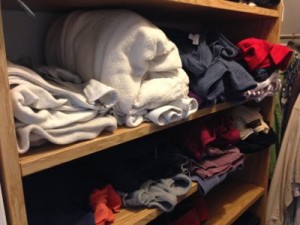
Closet shelves BEFORE: Nothing here is clutter, but it sure looks that way when they’re piled up like this.
And the sweaters and sweatshirts sitting slightly back on the shelf in the closet? I have grown to love their new arrangement. It looks like they’re peeking out from their perch instead of jumping out (screaming) at me when I enter the closet to reach for something.
The Experience
I’d be lying if I said it was a walk in the park. It was not. My body hurt from top to bottom after my big fold-a-thon. Physical exhaustion is sign for me that I’m moving a lot of energy, and taking on more than I can handle. I was too excited to slow down, and probably suffered more than I needed to.
Folding takes time. And folding in a particular way takes even more time and focus when you’re new at it. Each garment folded the KonMari way requires an additional three to four folds (to my usual two or three) to get it down to size. The smaller things require even more folds to get them to stand up on end.
Four drawers and two shelves took me two hours.
If you’re willing to do the work it takes on the front end, and allow some time to get used to the changes, I think you’ll agree that it’s worth it.
The Aha
It occurred to me after the fact that if I had broken down each task into smaller, more manageable sessions, AND handled each garment with more appreciation for its function in my life (rather than focusing on getting it right), it might have made the folding process more soothing and less exhausting.
Next time.
“Folding In” The Spacious Way
Folding clothes mindfully gives us a chance to honor their role in our lives, and honor ourselves by extension. Leaving clean clothes in the hamper to pull out at will, for example, does neither. Kondo makes this point loud and clear in her book as well.
Putting things away with awareness not only leads to a tidier space, but over time, it promotes well being and feels really good. Add compassion (i.e. no judgment) to your practice, and you’ve transformed a mindless housekeeping task you do almost every day (on auto-pilot) into nurturing, soul-filled experience.
That said, I don’t believe you need to fold and put away perfectly just so to receive the spacious benefit that the practice offers. If the KonMari way of folding feels too tight or rigid, too much to handle or too time consuming, I would suggest you dial it back. Fold the garment in a way that feels right to you (that isn’t shoving, wadding, jamming), and put it away with love.
I think that the “with love” part is the key here, not so much the perfect outcome.
Up next – Part 2: Taming Paper Clutter
Care to weigh in?
What are you experiences of the KonMari method? Tell us in the comment thread. We welcome your thoughts!
Dear Readers: If you found this message helpful, please forward it to someone else (or share, like, tweet, pin… ) and let’s build the clearing energy together that will help to lighten all of our loads!


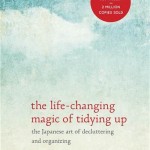
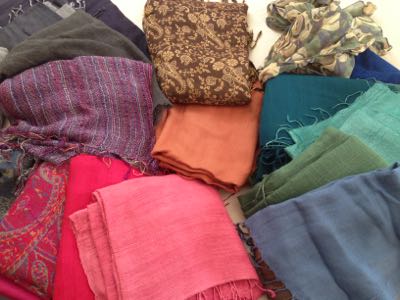
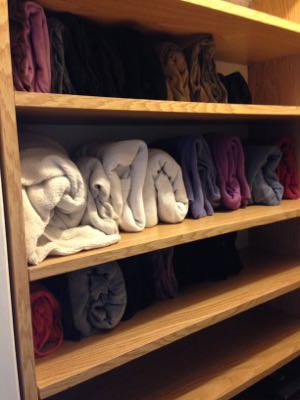



Hi Stephanie ,I love your gentle books but as usual my home is in such a mess that this book tempted me as I thought I could blitz the house and then get repairs done that I keep putting off .I did all my clothes in one day and filled 2 bin bags for charity ( they are still on the empty side of my bed a week later) .It felt good for a day and then I felt overwhelmed with the thought of doing the whole house so I did my usual habit of stopping and doing nothing .I have come back to your book again and am going to stop beating myself up and start reading back at the beginning of part 2 .I realise it is not clutter I have but a lot of things that don’t have homes .I have no routines or systems for laundry, cleaning ,papers ,uni stuff ,family papers ,craft things and am starting my own little business giving reki soon as well as my third year at uni so your gentle ,healing methods feel like a hug of hope ,thank you so much for your book ,website and daily om course – they are a blessing ,love and peace Patchouli
Thank you for your thoughtful comment, Patchouli and your kind words.
This clearing business is quite an adventure isn’t it? When one decides to go all in and attack the piles all at once, it becomes more like running a marathon that requires a lot of stamina and discipline.
Which is why I prefer a gentler approach that grows that discipline slowly. This approach may not result in getting all the garbage bags out the door right away. But my experience has shown that growing our clearing muscle the spacious way eventually leads to a lighter loads and to home tending that is way less exhausting and insanely more satisfying.
The work is the work. As Carlos Castaneda says “We either make ourselves miserable or we make ourselves strong. The amount of work is the same.”
Hang in there, Patchouli, and keep us posted on your small victories!
Stephanie
Hi there, I really the like your post. I have that book. I like her concepts but she is a little to OCD for me. However, I thought I’d try this because my way only works until I pull something out of the drawer. Then I toss it back and you know the rest of the story….
so have you done this with cotton jersey tops?
I guess pants, crops etc need to hand because to fold them would wrinkle them. Oy!
Hi Sharon,
I love that you tried it!
Yes, I folded EVERYTHING the KonMari way – cotton jersey tops and tees, cargos, pants, etc. Some of them got a little thick and bunchy, while others are so thin they flop around. Took a little while doing it, then another while getting used to it, and now I love my drawers and closet shelves. The real aha is that none of the clothes get wrinkled at all! (Who knew?). This new system does take some getting used to, and I agree it can feel a bit on the OCD side. It may not be for everyone. Still I love simple tips that can make a real difference over time, and Kondo’s folding tips, specifically, really resonate for me.
Your scarves look very nice in the drawer. But with shelves like those you have ( with little space between them ) it would look more “quiet” if clothes were folded then put in pile of 2 or 3 max with a nice finished touch on the front ( the folded side that hide the folding lines ) I’ve read MK’s book and I’ve adapted some folding ideas to look even nicer than suggested in the book. For example, it’s not useful to put vertically my towels, since they all look the same and I always take the one on top of the pile. So I make piles for every type of towels and always fold them the same way. Put together, it looks pretty neat. So why make them look like Danish pastry if you know what I mean. lol. That’s only a suggestion of course. But instead of seeing the folding lines on the side of the clothes, why not try to pile them by 2 or 3 like books: ( for the image: you only see the title and hide all the pages lol. ) 😉
Hi Stephanie,
I guess I am a slow drip girl all the way. I have been faced with many major house repairs this summer (like re-piping) in which I have had to deal with my stuff. When feeling overwhelmed I just remember you talking about stopping, breathing, noticing the “weather” of what’s passing through me and shifting some energy by doing one thing. Sometimes I would try your idea of sweeping or just doing one pile of stuff or papers and it is amazing to me how clearing one thing really does shift the energy! I have started to stop and honor that feeling, savor it. While I guess with this way there isn’t the full on rush of seeing everything cleared, cleaned and organized all at once but that option seems only doable if you can wave the magic wand and oila! it’s done. I haven’t read MK’s book but I do know how much yours has helped me. A Year to Clear sounds just right to me…the journey, not the destination. Thanks so much for your depth approach to clearing and living.
Hi Stephanie,
I decided to try the commando method of organizing-briefly. Your book had made profound, actually life-altering, changes in my mindset; my psychological/emotional- and financial-worlds are deeply indebted. But I thought I’d try the KM way to make faster progress in my physical world. I’m still regretting a’minimalism’ phase a few years ago, when I applied the ‘OUT if unused in a year’ rule and very quickly compiled and actually donated large quantities of beloved but yes, unused for a year, clothes, art supplies, books, kitchen goods, etc. Because almost immediately, and remaining now a few years later, I quickly realized the art supplies, many of the books, and much of the clothing IS still missed and would have been great to have due to rekindled artistic interests and a new job I found soon after my great purge. So, while I tried the KM way on a kitchen junk drawer, I know better than to use it on anything else. In a way it felt like forcing myself to give up items I didn’t want to give up, which was very stress-inducing, not the home feel I am going for! I was truly appalled-if I remember and am interpreting it correctly-at her recommendation to permanently remove items of others in your space without their knowledge or permission or blessings. I find that disrespectful beyond words. And so I remain highly successful as a devotee of yours for my internal space, and my outer space is a really comfy, peaceful work in progress! Can’t wait to read your next book. Thank you.
Hi Durga, I just read your experience, and it reminded me of how I also cleaned out radically in my apartment, many years ago. In my case, I later met my future husband, who lived in the US. I lived in Austria. I wound up moving to the US, and it actually was a blessing that I had got rid of so much stuff. I was very difficult to move my things to the US!
I’ve been listening to Marie Kondo’s book. I don’t have time to start from scratch, but I am using some of her thought processes for now as I handle things around the house and my office. I am letting go of a lot of stuff! I recently played a You Tube of George Carlin doing his routine about “Stuff!” that really helps to keep me focused on having less stuff.
I really appreciate your reminder to go gentle on myself, and it helped to consider Marie Kondo to be a bit OCD. My goal is to be surrounded by things that only bring me joy, and for there to be a place for everything and everything in its place…I hope this will give me a greater sense of peace in my home and in my office.
I am ready to begin…just from reading the beginning of things to come, I am looking forward to it. I will try to read the daily lesson the same time every morning and then put it into practice. Of course this is easier for me because I am retired and I have no children in our home. Let the adventure begin!!!
Hi Stephanie, I am on day 139 and I am reaping the benefits of your book. Space is happening on the inside and outside. I find when I leave an area of overwhelm and I simply notice it and nurture myself through compassionate thoughts. Well it seems that I get an idea perhaps the next day on a strategy that allows me to go and pick up that paper clip – LOL -. Yes life is about picking up paper clips. As for folding in the Kon Mari way I confess to learning that as a teenager and I even fold fitted sheets in such lovely fashion with a fair amount of mindful ease. I like the ease of seeing what is in an area. Anything I take the time to learn becomes easier with repetition. I imagine that if I was trying to learn that it would seem tedious. It is a wonderful process to discove how I relate to things and releasing some of that grief from my being, then the sorting and tidying begins to flow. I really see a light at the end of the tunnel. Thank you for your slow drip.
That’s fantastic, Maggie. Thank you for sharing your experience of working with the book. And yes, it is so fun to see the ease that comes over time with repetition – like magic.
Enjoy the journey and happy clearing!
I read Kondo’s book and also saw her in person. She speaks little english, a translator is present, but she is absolutely fascinating to watch, on You Tube or in person.
I love the Zen of her method. I ultimately folded most of my clothes that are in drawers per her ways and love it! It works for me yet I realize it’s not for everyone. I may have a touch of her OCD!
I did not, however, pull all my clothes out in a heap and review and touch them before deciding what to keep because it gives me joy; for purging I removed what didn’t fit or I haven’t worn in some time. This is not Kondo’s method I know. I so plan to do this …
I just signed up for your course. I think my closet clutter problem may be in part about hoping I can get back into clothes that don’t fit since I gained a little weight. If you don’t address it in your 365 day program, what are your thoughts?
I have found that if I modify her method just a little, it feels better and works better for me. i fold into thirds (most things- basically, I am just folding to the right height when they are standing) and then ai roll the item and stand it in my drawer- or in my case,cit is my baskets- I gave up on drawers years ago. This is easier and less tedious for me, so when I change my mind after unfolding something, it is easier to refold. I’m sure it takes up more space than making the rectangles, but my clothes feel happier rolled up (:.
Four years later and “clear the clutter” practice is alive and well, except “the overwhelm” continues as I slow down and energy is lower and scattered. A lot going on mentally, emotionally and physically. The story about aging, changing and the dire urge to simplify can get cumbersome. Life is busy, life is full, and so it is. So grateful but discouraged big time as the days fly by and the “clutter” takes over.
Thank you for your books, blogs and joys of moving through the chaos. Determined to stay inspired!
Hi Stephanie. I read and loved Marie Kondo’s book,. got as far as reorganizing the drawers and closet in my bedroom but the idea of collecting my clothes from all over the house and putting them on the floor overwhelmed me. I’ve continued “clearing” but it is more in your way of doing it. Slowly, bit by bit. I am a student of the Feldenkrais method and your way fits more into the way I am learning to live my life–without straining as my master teacher, Mia Segal, would say. It’s interesting though, I only heard of your course 2 days ago, started yesterday. I had already decided to take a year 2017 to slow down and clear my life, staying in the “range of ease” (another Feldenkrais “learning”. Your course will be a perfect support and enhancement on the path. Thanks.
Hello,
I want to share my perspective as a person diagnosed with ADHD, or, as I like to call it, intentional focus deficit.
One of my challenges is an intense talent for “Out of sight, out of mind.” Early in my life, this quality lead to piles of clothes and papers, because if I can’t see it, I forget I own it.
They way this relates to Marie Kondo is, when I saw her clothes folding and storing method, I realized what she was trying to do was to make all our clothes visible at once. In drawers, stacks of clothes leave only the top one of whatever it is on view. My solution is different. I store my tee shirts, pajamas, etc. in a cupboard with shelves. As soon as I open the doors, I can see every choice in a nice, neat stack.
We don’t have to fold the special Kondo way to achieve the goal of seeing and using all of our clothing choices. In clearing in general, there are techniques that work better for some of us, not for others. It’s the goal of the technique we need to keep in mind as we curate our homes.